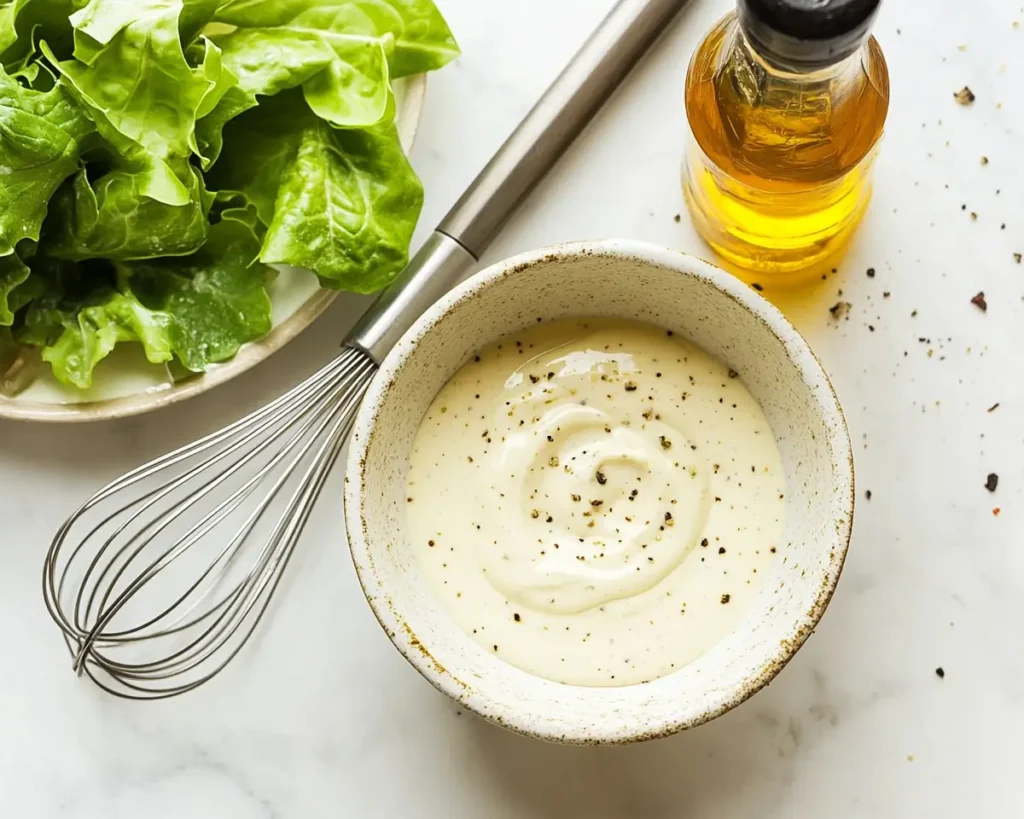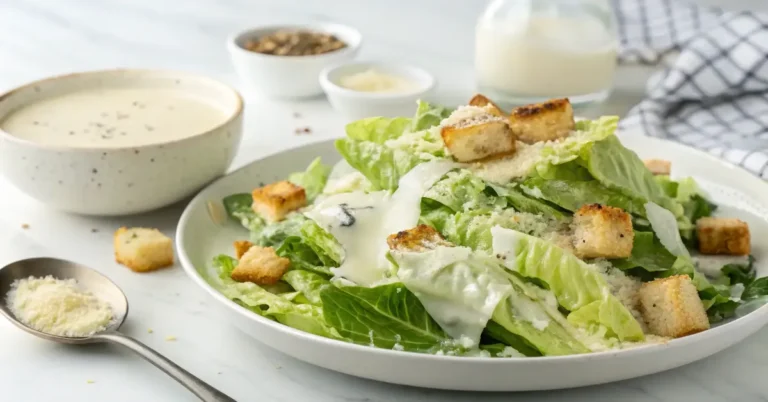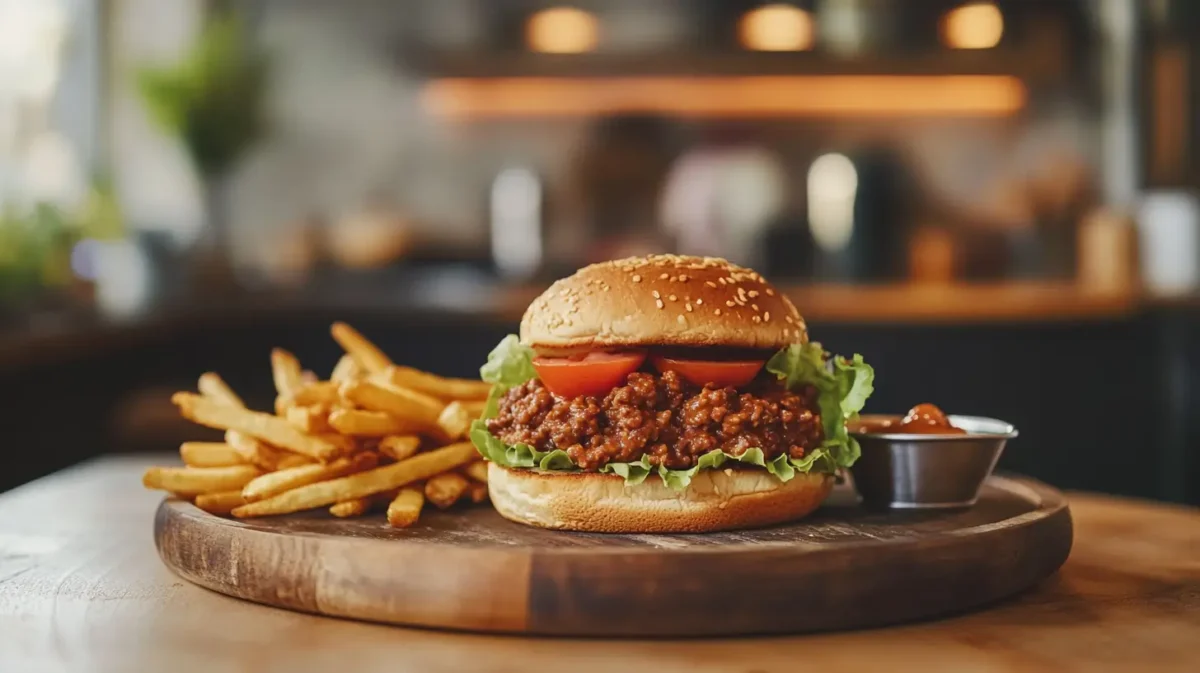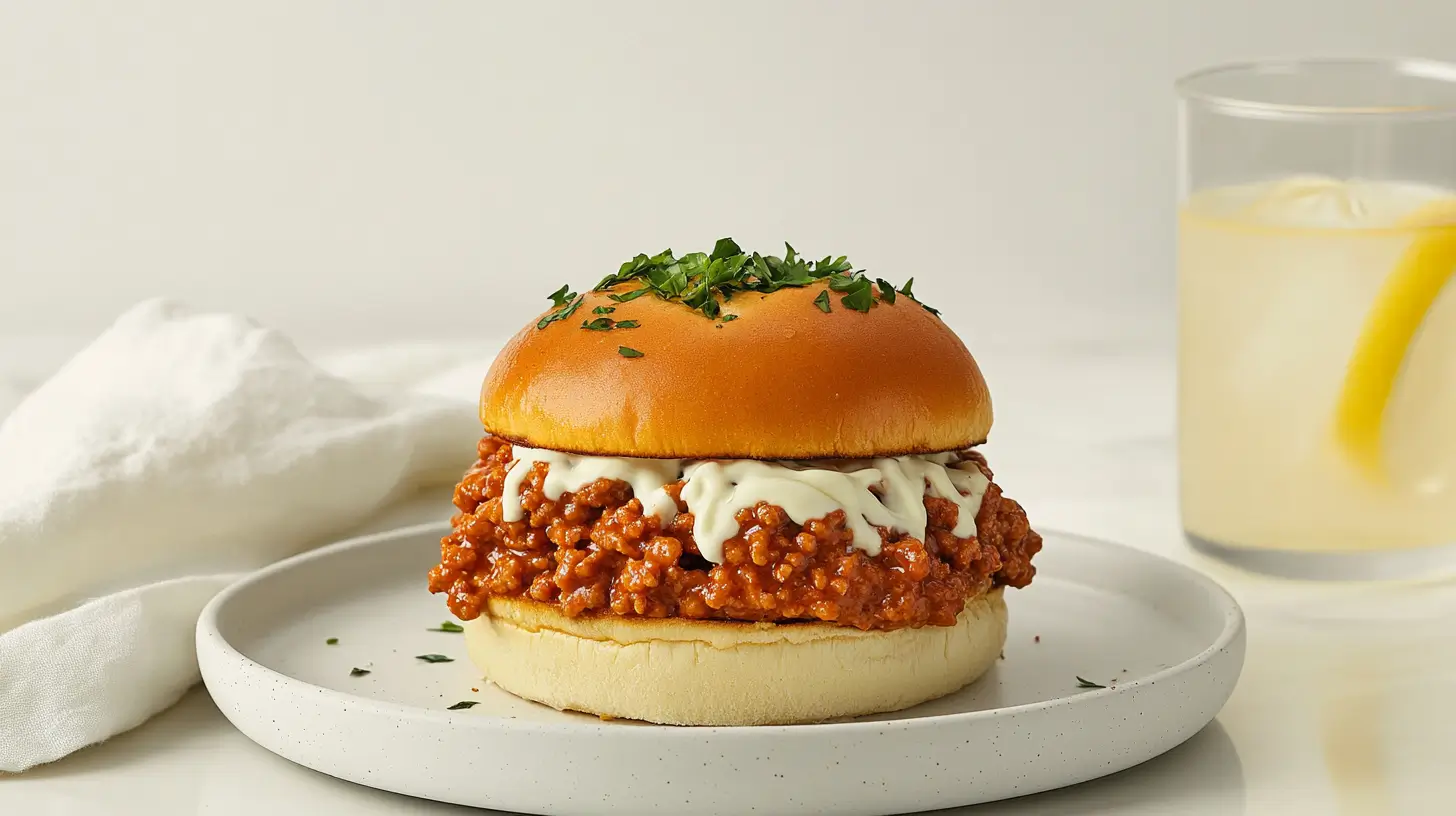How to make Caesar salad dressing is a question many home chefs ponder when aiming to recreate the classic, bold flavors of this beloved dressing. Originating from a blend of savory and creamy elements, Caesar salad dressing is known for its tangy, umami-rich taste. The perfect combination of ingredients provides a balance that enhances the crispness of romaine lettuce, making it a favorite choice for salads worldwide.
Making this dressing at home not only ensures freshness but also allows customization to suit individual taste preferences. From the rich creaminess of egg yolks to the distinctive saltiness of anchovies or Worcestershire sauce, every component plays a crucial role. In this guide, we’ll explore every aspect of how to make Caesar salad dressing, including its history, essential ingredients, tools required, step-by-step preparation, and tips for achieving the perfect consistency.
History and Origin of Caesar Salad
To fully appreciate how to make Caesar salad dressing, it’s essential to understand its origins. Contrary to popular belief, the Caesar salad was not named after Julius Caesar but after Caesar Cardini, an Italian-American restaurateur. Cardini invented this iconic salad in 1924 in Tijuana, Mexico, during a busy Fourth of July weekend when his restaurant’s supplies were running low.
Legend has it that Cardini improvised using what was left in his kitchen, tossing whole romaine leaves with a bold dressing made from egg yolks, olive oil, lemon juice, Worcestershire sauce, and Parmesan cheese. The salad quickly gained popularity, known for its theatrical table-side preparation and unique flavor profile. Understanding this rich history adds depth to the experience of learning how to make Caesar salad dressing from scratch.
Why Make Caesar Salad Dressing at Home?
When considering how to make Caesar salad dressing, one might wonder why bother making it at home when store-bought options are readily available. The answer lies in the freshness, flavor, and control over ingredients. Commercial versions often contain preservatives, artificial flavors, and excessive sodium, which can compromise the dressing’s authentic taste.
Making Caesar salad dressing at home allows you to:
- Control the quality of ingredients, ensuring freshness and flavor. If you’re making a full meal, try pairing it with this Chicken Caesar Salad guide
- Adjust the taste by tweaking elements like garlic, lemon juice, or anchovies.
- Avoid preservatives and additives commonly found in packaged products.
- Experiment with consistency, achieving the perfect creamy or slightly emulsified texture.
By mastering how to make Caesar salad dressing, you can create a version that suits your taste buds while maintaining the integrity of this culinary classic.
Essential Ingredients
Knowing the essential ingredients is key to mastering how to make Caesar salad dressing. Each component plays a specific role in creating the rich, umami-packed flavor profile that distinguishes this dressing.
Anchovies or Worcestershire Sauce?
One of the most debated aspects of how to make Caesar salad dressing is the choice between anchovies and Worcestershire sauce. Traditional recipes use anchovies for their bold, salty, umami flavor, which adds depth and complexity. Anchovies are rich in glutamates, contributing to the savory taste that defines Caesar dressing.
However, some prefer Worcestershire sauce as a substitute due to its milder, slightly sweet undertones, derived from a blend of vinegar, molasses, and spices. While Worcestershire sauce is a convenient option, purists argue that anchovies provide a more authentic flavor. Ultimately, the choice depends on personal preference, but using high-quality anchovies often yields a richer, more robust dressing.
The Role of Egg Yolks
Egg yolks are essential when learning how to make Caesar salad dressing, as they serve as an emulsifier, creating a creamy, cohesive mixture. The richness of egg yolks provides the luxurious texture characteristic of authentic Caesar dressing. Traditionally, raw egg yolks are used, but for safety, pasteurized eggs are a good alternative.
Egg yolks also contribute to the dressing’s golden hue and enhance the overall flavor by adding a subtle richness. Without them, the dressing would lack its creamy consistency and depth, underscoring their importance in the recipe.
Choosing the Right Olive Oil
Olive oil is another crucial element in how to make Caesar salad dressing, as it serves as the primary fat that binds the other ingredients together. Extra virgin olive oil is the preferred choice due to its robust flavor and high-quality nutritional profile. Its slightly peppery taste complements the savory components of the dressing, such as Parmesan cheese and garlic.
However, the intensity of extra virgin olive oil can be overpowering if not balanced correctly. To avoid a bitter taste, it’s recommended to blend it with a neutral oil, like grapeseed or canola oil, ensuring a smooth, harmonious flavor.
Tools Needed
To master how to make Caesar salad dressing, having the right tools is just as important as the ingredients. The tools required are simple yet essential for achieving the perfect consistency and flavor.
- Mixing Bowl: A medium-sized bowl for whisking the ingredients.
- Whisk or Immersion Blender: For emulsifying the dressing to a smooth, creamy texture.
- Garlic Press: To finely crush garlic, maximizing its flavor.
- Measuring Cups and Spoons: Ensuring precise measurements for balanced taste.
- Microplane or Grater: For finely grating Parmesan cheese.
Using these tools makes the process of how to make Caesar salad dressing more efficient and helps achieve professional-quality results.
Step-by-Step Guide: How to Make Caesar Salad Dressing
Follow this detailed guide on how to make Caesar salad dressing to achieve the perfect balance of flavors and consistency.
- Prepare the Anchovy-Garlic Base:
- Mince 4-5 anchovy fillets with 2 cloves of garlic until a fine paste forms. Looking for a different twist? Check out how to make Sloppy Joes taste better for another bold-flavored dish.
- Transfer to a mixing bowl.
- Add Egg Yolks and Mustard:
- Whisk in 2 egg yolks and 1 teaspoon of Dijon mustard, enhancing the dressing’s richness.
- Incorporate Lemon Juice and Worcestershire Sauce:
- Stir in 2 tablespoons of fresh lemon juice and a dash of Worcestershire sauce for acidity and depth.
- Gradually Add Olive Oil:
- Slowly drizzle in ½ cup of extra virgin olive oil while continuously whisking to emulsify the dressing.
- Season and Finish:
- Mix in ½ cup of freshly grated Parmesan cheese.
- Season with salt and pepper to taste.
Tips for the Perfect Consistency
Consistency is key in how to make Caesar salad dressing. Here are some tips to achieve the ideal texture:
- Emulsification is essential: Whisk vigorously or use an immersion blender for a smooth, cohesive dressing.
- Adjust thickness: If the dressing is too thick, add a small amount of water or lemon juice. If too thin, incorporate more Parmesan or olive oil.
- Chill before serving: Allow the dressing to sit in the refrigerator for at least 30 minutes to let the flavors meld and the consistency to thicken slightly.

Variations of Caesar Salad Dressing
One of the exciting aspects of learning how to make Caesar salad dressing is discovering the numerous variations that cater to different tastes and dietary preferences. By tweaking the traditional recipe, you can create a variety of delicious options while maintaining the classic bold flavor.
Creamy Caesar Dressing
For those who enjoy an extra rich and velvety texture, Creamy Caesar Dressing is a fantastic variation. This version typically includes mayonnaise or sour cream to enhance the creaminess while preserving the signature umami flavor. Here’s how to make this indulgent version:
- Ingredients Needed:
- ½ cup mayonnaise or Greek yogurt
- ¼ cup freshly grated Parmesan cheese
- 2 anchovy fillets (or 1 teaspoon anchovy paste)
- 1 clove garlic, minced
- 2 tablespoons fresh lemon juice
- 1 teaspoon Dijon mustard
- Salt and pepper to taste
- Instructions:
- In a bowl, combine the mayonnaise, Parmesan cheese, minced garlic, and anchovy paste.
- Stir in lemon juice and Dijon mustard, mixing well.
- Season with salt and pepper to taste.
- Whisk until smooth and creamy.
This version is perfect for those who prefer a thicker, more luxurious texture while mastering how to make Caesar salad dressing.
Spicy Caesar
For a bolder twist, Spicy Caesar Dressing adds a kick by incorporating chili flakes or hot sauce. This variation is ideal for those who enjoy a bit of heat balanced by the dressing’s creamy, umami-rich base.
- Ingredients Needed:
- 2 egg yolks
- 4 anchovy fillets
- 1 clove garlic, minced
- ½ cup extra virgin olive oil
- 2 tablespoons lemon juice
- 1 teaspoon Dijon mustard
- 1 teaspoon red pepper flakes or hot sauce
- Salt and pepper to taste
- Instructions:
- In a mixing bowl, mash the anchovy fillets with minced garlic to form a paste.
- Whisk in the egg yolks, Dijon mustard, and lemon juice.
- Gradually add olive oil while continuously whisking to emulsify the mixture.
- Stir in the red pepper flakes or hot sauce for the spicy element.
- Season with salt and pepper to taste.
This fiery variation is a fun and flavorful option when exploring how to make Caesar salad dressing with a twist.
Vegan Caesar
For those looking for a plant-based alternative, Vegan Caesar Dressing replicates the classic flavors without using animal products. The key is to substitute traditional ingredients with vegan-friendly options that deliver the same creamy and savory taste.
- Ingredients Needed:
- ½ cup raw cashews (soaked for at least 4 hours)
- 2 tablespoons nutritional yeast (for the umami flavor)
- 2 tablespoons lemon juice
- 1 tablespoon Dijon mustard
- 1 teaspoon capers (to mimic the anchovy flavor)
- 1 clove garlic, minced
- ½ cup water (adjust for desired consistency)
- Salt and pepper to taste
- Instructions:
- Drain the soaked cashews and add them to a blender with nutritional yeast, lemon juice, Dijon mustard, capers, and garlic.
- Blend until smooth, gradually adding water to reach the desired consistency.
- Season with salt and pepper to taste.
This version is perfect for vegans or those with dietary restrictions while preserving the essence of how to make Caesar salad dressing.
How to Store Caesar Salad Dressing
Proper storage is crucial when learning how to make Caesar salad dressing to maintain its freshness and flavor. Homemade Caesar dressing, especially those containing raw egg yolks, should be stored correctly to ensure food safety.
- Storage Tips:
- Airtight Container: Store the dressing in an airtight container to prevent oxidation and contamination.
- Refrigeration: Keep the dressing refrigerated at all times. Homemade versions typically last between 3 to 5 days.
- Separation Fix: If the dressing separates, simply whisk it again before use to restore the emulsified texture.
By following these guidelines, you can enjoy the bold, fresh flavors of your homemade Caesar dressing for days after preparation.
Common Mistakes to Avoid
Mastering how to make Caesar salad dressing requires attention to detail to avoid common pitfalls. Here are some frequent mistakes and tips on how to prevent them:
- Using Low-Quality Olive Oil: Poor-quality olive oil can lead to a bitter taste. Opt for high-quality extra virgin olive oil for the best flavor. Pairing the right ingredients is key in any dish—learn more with this Chicken Caesar Salad guide.
- Incorrect Emulsification: Failing to slowly incorporate the olive oil can result in a separated dressing. Always add the oil gradually while whisking vigorously.
- Overpowering Garlic Flavor: Too much raw garlic can overwhelm the dressing. Use a microplane for a fine mince to better control the intensity.
- Storing Too Long: Homemade Caesar dressing doesn’t contain preservatives. Always consume within the recommended time frame to ensure freshness and safety.
By avoiding these common mistakes, you can consistently produce a delicious, well-balanced Caesar salad dressing.
Serving Suggestions
When learning how to make Caesar salad dressing, it’s useful to know the best ways to serve it. While the classic pairing is with crisp romaine lettuce and croutons, there are many creative ways to use this versatile dressing:
- Traditional Caesar Salad: Toss with chopped romaine, homemade croutons, and freshly grated Parmesan.
- Grilled Vegetables: Drizzle over grilled asparagus or roasted Brussels sprouts for an umami boost.
- Marinade for Protein: Use as a marinade for chicken or shrimp, adding rich flavor before grilling.
- Dip for Snacks: Serve as a dipping sauce for crudités, breadsticks, or even crispy potato wedges.
These serving suggestions illustrate the versatility of Caesar dressing beyond just salads.

Nutritional Information
Understanding the nutritional profile is an important aspect of mastering how to make Caesar salad dressing. Here’s a breakdown of the traditional version per serving:
| Nutrient | Amount per Serving |
|---|---|
| Calories | 160 |
| Total Fat | 17g |
| Saturated Fat | 3g |
| Cholesterol | 35mg |
| Sodium | 320mg |
| Total Carbohydrates | 1g |
| Protein | 2g |
These values can vary depending on the specific ingredients and portions used. Opting for lighter versions, such as using Greek yogurt or reducing the amount of Parmesan, can help reduce calories and fat content.
FAQs about Caesar Salad Dressing
Can I Make Caesar Salad Dressing Without Anchovies?
Yes, you can absolutely make Caesar salad dressing without anchovies while still achieving a delicious, umami-rich flavor.
For another classic comfort dish, check out how to make Sloppy Joes taste better.
Anchovies are traditionally used to add depth and saltiness, but there are several effective substitutes:
- Worcestershire Sauce: This is a popular alternative as it contains anchovy essence but in a milder form, offering a similar umami punch.
- Soy Sauce or Miso Paste: For a vegetarian option, a small amount of soy sauce or white miso paste provides a savory depth comparable to anchovies.
- Capers: Minced capers can replicate the briny, salty taste, adding complexity without the use of fish.
These alternatives ensure that you can master how to make Caesar salad dressing even if you prefer to avoid anchovies for dietary or taste reasons.
Is It Safe to Use Raw Egg Yolks?
One common concern when learning how to make Caesar salad dressing is the use of raw egg yolks. Traditional recipes use raw yolks for their emulsifying properties, which give the dressing its creamy texture. However, there are safety considerations to keep in mind:
- Risk of Salmonella: Raw eggs carry a small risk of salmonella contamination. To minimize this risk, use pasteurized eggs, which have been heat-treated to kill bacteria without cooking the egg.
- Alternatives to Raw Yolks: If you’re uncomfortable with raw eggs, you can substitute with mayonnaise or Greek yogurt, both of which provide creaminess without raw egg risks.
- Storage and Handling: Always store homemade Caesar dressing in the refrigerator and consume it within 3 to 5 days to maintain freshness and safety.
By taking these precautions, you can safely enjoy authentic Caesar salad dressing with its characteristic richness.
How Long Does Homemade Caesar Dressing Last?
Knowing how long your dressing stays fresh is crucial in mastering how to make Caesar salad dressing. The shelf life depends on the ingredients used:
- With Raw Egg Yolks: If made with raw egg yolks, the dressing should be consumed within 3 to 5 days and stored in an airtight container in the refrigerator.
- Without Raw Eggs (using Mayo or Yogurt): Versions made with mayonnaise or Greek yogurt last slightly longer, typically up to 7 days when properly refrigerated.
- Signs of Spoilage: Always check for changes in smell, color, or texture before consuming. If the dressing smells sour or has separated excessively, it’s best to discard it.
Proper storage ensures you can safely enjoy your homemade Caesar dressing for several days.
Can I Use a Blender Instead of a Whisk?
Yes, using a blender or an immersion blender is a great alternative when learning how to make Caesar salad dressing. In fact, a blender can help achieve a perfectly emulsified, creamy consistency with less effort than whisking by hand.
- Benefits of Using a Blender:
- Ensures a smoother texture by fully emulsifying the oil and egg yolks.
- Speeds up the process, making it more convenient for larger batches.
- How to Use a Blender:
- Combine all the ingredients except the oil in the blender.
- Start blending on low speed.
- Gradually drizzle in the olive oil until the dressing thickens and emulsifies.
Using a blender is particularly useful when experimenting with variations like Creamy Caesar or Spicy Caesar dressings, ensuring a silky, cohesive blend.
Is There a Vegan Version of Caesar Dressing?
Absolutely! There are several delicious ways to make vegan Caesar salad dressing while maintaining the bold, savory flavor profile.
For more creative food ideas, explore whether you should put mayo on Sloppy Joes.
Traditional non-vegan ingredients like anchovies, egg yolks, and Parmesan cheese can be substituted as follows:
- Egg Yolk Substitute: Use soaked cashews or silken tofu for creaminess.
- Anchovy Substitute: Capers or seaweed flakes provide a similar briny, umami flavor.
- Parmesan Substitute: Nutritional yeast adds a cheesy, savory element without dairy.
- Dressing Base: Blend the substitutes with olive oil, lemon juice, garlic, and Dijon mustard for a cohesive flavor profile.
This version not only caters to vegans but also suits those with egg or dairy allergies, proving that learning how to make Caesar salad dressing can be inclusive and adaptable to different dietary needs.
Conclusion
Mastering how to make Caesar salad dressing opens up a world of culinary possibilities. From understanding its rich history to experimenting with creamy, spicy, or vegan variations, this dressing is incredibly versatile. By using fresh, high-quality ingredients and following the proper techniques, you can craft a Caesar salad dressing that surpasses store-bought versions in both flavor and nutrition.
Whether you’re preparing a classic Caesar salad or getting creative with serving ideas, homemade Caesar dressing is a delightful addition to any kitchen. Enjoy the process and make each batch your own by experimenting with flavors and consistency. Happy cooking!





